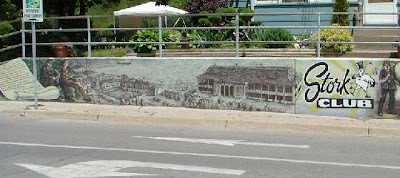Blog 10, June 2012
The personalities of places shift and change as time passes: industries
close, buildings are demolished and roads are created or widened. It's
all an inevitable function of progress - some popular, some not - but it’s
always accompanied by subtle shifts and changes in our sense of the roots,
background and purpose of our surroundings. I was recently in Port
Stanley, a small village perched on the northern shore of Lake Erie with the
lights of Cleveland glowing faintly in the distance on a clear night (Port Stanley is named after the hockey
Cup dude btw). Around the beginning of the 20th century it was a
prominent port with a thriving fishing industry and throngs of tourists
flooding the beach in the summer. In the
evenings thousands of people danced to the music of Woody Herman or Tommy
Dorsey in two of the largest dance halls in the country. As time passed, trucks
replaced Great Lake shipping, local fishermen faced tough competition and when
the Stork Club burned in 1979, disco had taken over and it was never rebuilt. The
tourists still flock to the long open beach, but most everything else has changed.
The residents of
Port Stanley haven't forgotten these important elements of their history though
and keep their memories alive with a series of outside murals painted by local
artists.
This piece is part of a large heritage presentation covering a
wall at the corner of a busy street. The Stork
Club has its own museum now, boasting records, music scores, posters and the
original grand piano which was played by Count Basie and other jazz greats. The museum also organizes ballroom dancing classes to recreate some
of the romance of the era, so we can all brush up our moves. I’d give anything to spend an evening dancing my feet off with my childhood idol Stan Kenton on the bandstand.
The
bravery of members of a local lifeboat crew is memorialized on a wall in the
harbour recounting the heroic rescue of sailors on an American vessel run
aground in a surprise storm in the early 1900's…the men worked all night to
save everyone on board. Their courage was rewarded by a tribute from President
Teddy Roosevelt and this mural near the site of the incident.
As well as the
historical events captured by artists, many people have commissioned paintings
of seascapes and flowers on their fences and the walls of their houses - unlike the surfaces in my neighbourhood, they haven't been embellished by Banksey
wannabees. And a somewhat unsightly
couple of remaining oil tanks that are still in use have been made to fit into
the landscape with tall ships on their sides.
The harbour isn’t dredged out to accommodate large vessels any more –
another one of those losses – so we have to be content with the murals to
remind us. There’s a wonderfully vibrant community of artists in Port Stanley and this is a shout out to them for creating a setting that both keeps our past alive and beautifies our
present.





